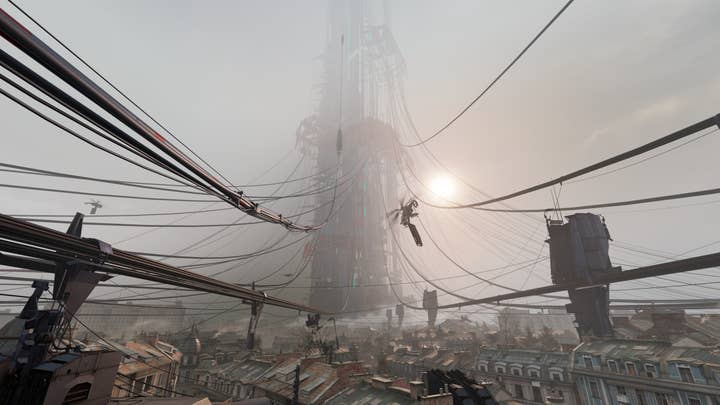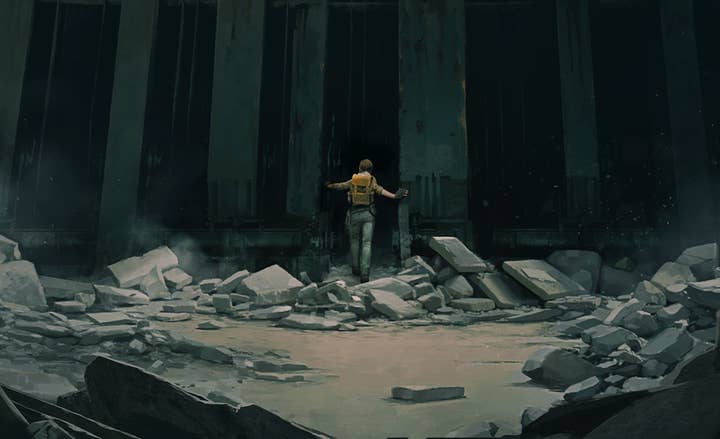Valve: "VR has been missing a big game that everyone can get excited about"
Valve's Corey Peters and Sean Vanaman on making the first Half-Life game in 13 years, with novices to both VR and the celebrated series in mind
Nearly 13 years after the release of Half-Life 2: Episode Two, Valve has provided an answer to one of the most commonly asked questions in video games.
Well, almost.
Half-Life: Alyx isn't quite Half-Life 3, the phantom product that Valve has evaded all discussion of for more than a decade. It isn't a sequel, for a start -- it takes place between the first and second games, rather than continuing a story whose last chapter ended so dramatically and inconclusively in 2007. It is also exclusive to virtual reality, the market that Valve has worked so hard to establish in recent years, and which still represents just a tiny fraction of the overall gaming market.
Half-Life: Alyx, then, is an odd beast: a truly major event in video games, but one that will remain beyond the grasp of the people that most fervently wished for its existence. It is an experience built on the assumption that a significant chunk of its addressable market will have little understanding of the original games, but must also satisfy the fans that do own VR hardware.
"There is a not inconsiderable number of Index customers whose headsets will show up in the mail this week"
Sean Vanaman
In that sense, Valve's Sean Vanaman seems cautiously optimistic that it eventually found the right balance. The events in Half-Life: Alyx, he tells GamesIndustry.biz, do not require deep knowledge of series lore to understand, but it is still "a quintessential piece of the story" that will "pay dividends" to those who are grounded in its history.
"For the three writers on the game -- myself, Jay Pinkerton, and Eric Wolpaw -- one thing that felt a little bit insurmountable is the prequel problem," he says. "Like, 'and that's how this got formed', or 'and that's how Darth Vader got his mask'. People do want a little bit of that, so how do you get the fan nods into the story but keep it natural, and also make it feel like an entry in the franchise, and not just the backstory of something you already knew before? That was super, super hard."
In most other respects, however, Half-Life: Alyx has been made with an unusual amount of focus on novices -- especially for the fifth game in a beloved franchise.
"There is a not inconsiderable number of Index customers whose headsets will show up in the mail this week, and on Monday they'll play the game," Vanaman says. "This will be their introduction to the whole shebang, so the product has to be good for those people."

According to level designer Corey Peters, Valve tested the game on a broad variety of players on two distinct scales: familiarity with the Half-Life series, and experience with virtual reality. The goal was to create a game that could be played by someone inexperienced with both, but my conversation with Peters and Vanaman made it clear that, of the two, VR was the great leveller.
"It's one thing to make a regular shooter and assume that the player knows how to move around and fire their weapon, but in VR it's such a physical experience that you have new skills to learn," Peters says. "A big portion of the early part of the game is learning how to use a pistol, how to reload the pistol, and fire at enemies.
"We try to slowly increase the level of threat over time, so when you start out you're fighting a barnacle -- a barnacle is not a tough enemy to fight, but it's gonna get you to reload your gun, and learn that skill over and over again."
"VR is such a physical experience that you have new skills to learn"
Corey Peters
It may seem odd for the series that introduced the Gravity Gun -- hugely innovative in its time -- to place such importance on working a simple pistol, but that contrast is indicative of what VR brings to the experience. In the game's early stages, for example, the player encounters a zombie stuck behind a fence, able to grasp and bite but offering no real threat. When the player finally reaches a zombie that can attack them, the design team noticed how powerful the tactile interactions afforded by VR can be.
"The zombie would come shambling down the hall, and the player would grab a clip, try to reload, drop the clip on the floor, fumble a little bit, then the zombie would come over and kill them," Peters says. "As game designers, we looked at that as [the player] failing to kill the first zombie that can get to you. But the players would take the headset off and say, 'That was amazing. That was so much fun'."
The one-to-one movement of VR is a fertile environment for emergent drama of this kind. Traditional games have experimented with random elements like guns jamming, Vanaman says, but the Half-Life: Alyx team were consistently surprised at how frequently simple encounters would become memorable purely by chance -- an outcome of their choices and emotional state bumping colliding with the systems and physics of the game.

Peters recalls the earliest tests for Half-Life: Alyx, which were little more than greybox rooms scattered with headcrabs and zombies.
"When we started, we looked at Half-Life 2, and [thought] players are going to get tired of zombies after five minutes. You kill a couple of zombies, you move on to the next room, more zombies -- okay I get it, time to move on. [But] as we improved on the gun mechanics in the game, players were still having fun fighting zombies for quite a period of time."
When people discuss Half-Life now, they often point to set-pieces like the Ravenholm in Half-Life 2, or the epic Strider battle towards the end of the second episode. Half-Life: Alyx has these moments, Vanaman says, but he seems more enthusiastic about the time he faced down a single, powerful enemy with two shotgun shells left, using cover to edge closer without being seen. While not a blockbuster moment on paper, the reality of having to load each cartridge into the gun and physically crouch to stay out of view made it the most powerful encounter he had with the game.
"the game slows down, and that affects the level designers, it affects the way we space out combat -- it affects everything"
Sean Vanaman
"We have to be really cognisant of how intense the game can feel once you strap that headset on," Peters says. "You're going through all the same emotions that you would if you were there... There are parts of the game that will be intense, but then we try to have a moment afterwards where you can breathe, take your time a little bit, where you can explore -- just to gather yourself back up."
As a series, Half-Life is known for balancing combat with exploration and innovative puzzles, to the point where Peters believes that the series' essential DNA is really in its pacing. VR had the effect of focusing combat design on the details -- loading a cartridge into a handgun and pulling the cocking handle, for example -- and it became clear from those early greybox tests that it would have a similar effect on these moments of calm.
"As we started to add art into each of these spaces, players spent more and more time exploring," Peters says. "They would lift up the box, they would look under the table, stick their head in the vent. We watched player after player do this, and it gave us an opportunity to spend resources effectively on putting things under the box, and in the vent. It offered us the excuse -- as a bunch of artists and writers and level designers -- to reward that type of exploration."

Vanaman adds: "People slow down so much. That's in contrast to how fast your character moves in Half-Life games traditionally. You're very, very, very fast in those games, and at the furthest end of the bell curve on the other extreme is how slow people go [in VR].
"And as the level of detail in the environment goes up, the speed goes down... That ends up being really nice for a lot of the tone and mood-setting stuff that we want to do. It means that we can tell a whole bunch of story in a really tight space.
"We did not want people to think that this was us making sure everyone bought an Index"
Sean Vanaman
"That's definitely a production challenge. You do a level of detail pass, and the game slows down, and that affects the level designers, it affects the way we space out combat -- it affects everything... There's an interplay between art, and design, and story, and the fidelity of all of those things going through the roof."
Half-Life: Alyx will be available on all hardware compatible with SteamVR, which includes HTC Vive, Oculus Rift and Quest (but only while connected to a PC), and of course, Valve's very own Index headset. The game itself, Peters says, will be exactly the same across all devices, with the only differences being to "the quality of the visuals" -- the fidelity that Vanaman insists Valve has pushed so far.
"On the Index, we think, it's probably the ideal experience," Peters saus. "With a high-end PC you're going to experience the game in its full glory. With the Oculus Quest it works great -- I've played it through a couple of times using the Oculus, and really the only trade-off it makes is in the visual fidelity... We tried to make sure you're getting the same experience that everybody else is, but much like when someone upgrades their video card, they're going to get a higher fidelity experience [with Index]."
Vanaman adds: "It was really important to us for that to be true. We did not want people to think that this was us making sure everyone bought an Index. The Index has its own business goals -- to push the state of the art forward -- but it was really important for us that fans didn't feel we were dragooning them into a purchase by holding a franchise they cared about hostage."
Half-Life: Alyx certainly had an observable impact on fortunes of the Valve Index, with many regions running out of stock and analysts estimating that sales doubled in the two months following the announcement. However, while it's only logical for Valve's hardware to be seen as the target platform for its own game, there is no doubt that Peters and Vanaman understand that Half-Life: Alyx has a larger significance than any one headset.
"I can't say that we've looked at it as this moment in VR, but we've definitely looked at the game as a product that hopefully makes VR a lot more accessible to a lot more people," Peters says. "I think that the one thing VR has been missing is a big game that everyone can get excited about. Where you can invite your friends over, jam them into the headset, and just have them experience this thing."

